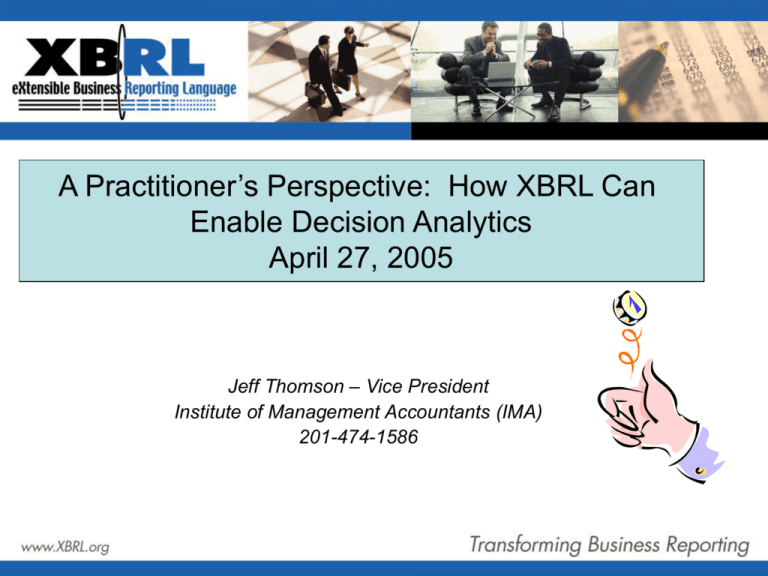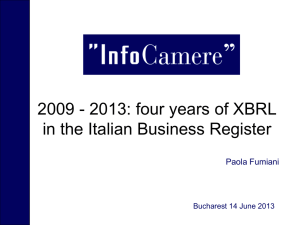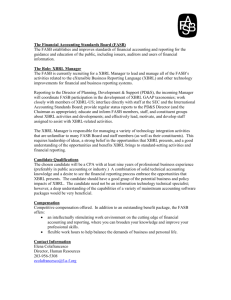Data Mining
advertisement

A Practitioner’s Perspective: How XBRL Can Enable Decision Analytics April 27, 2005 Jeff Thomson – Vice President Institute of Management Accountants (IMA) 201-474-1586 Who Said It ???? “It’s not the strongest of the species that survive, nor the most intelligent, but the one most responsive to change” …. AGENDA A Practitioner’s Lament: Where were you when I needed you ? ? XBRL-GL Enablement for Decision Analytics Newbie Perspective: XBRL Issues and Challenges IMA’s Role in Transforming Business Reporting A Practitioner’s Lament A major telecom successfully implemented two major decision support capabilities PRIOR to the height of their popularity: An integrated set of measures for decision support, planning and control (aka Balanced Scorecard) Data Mining But, these successes were not sustainable Punch Line: Future Sweet Spot for XBRL-GL ? A Practitioner’s Lament (cont’d) Decision Tool Initial Success Deployed in 60 days; Balanced Scorecard, aka, on- financial & nonfinancial measures: line Dashboard customer, people, operational, financial (“EVA, PVA, CVA”). Data Mining Identified quality sales force leads by correlating seemingly unrelated transaction and summary detail across databases. Why Not Sustainable XBRL-GL enablement Cost prohibitive – integrating transaction & summary data from disparate systems (CFO, HR, etc.) Tagged relational data easier to source and integrate within a “domain”. Filtering/alarm functionality. Cost prohibitive – data reprocessed and transformed. HUGE issue – consistent Customer Identification across databases. Data re-processing and re-keying minimized or eliminated. Consistent Customer tagging across databases enabled (maybe not solved) by XBRL. XBRL – GL Enablement for Decision Analytics XBRL seems to be a “natural” for helping to transform the internal information supply chain (but much work needs to be done): 1. 2. Business Reporting Decision Analytics – Balanced Scorecards/Integrated Performance Mgt – Data Mining – Continuous on-line auditing – Business Activity Monitoring (BAM) – Other web based auditing and modeling capabilities Problem Statement: Per “Professor” Eric Cohen How do you efficiently move detailed information between disparate accounting systems? How do you deal with different transactional XML standards and efficiently map them to GL systems? How do you represent the information in back-end accounting in a standardized format for data transfer, archival and audit purposes? How do you drill down from XBRL reports to the underlying detail? To Meet the Need: XBRL-GL XBRL GL, the Journal taxonomy Integrates accounting systems Provides detail later summarized in Financial reporting Tax Performance Represents almost anything categorized to "accounts“ Customer and vendor master file information Detail journals Information represented in US, Japanese or European general ledger packages XBRL Spans the “GAP” XBRL GL provides platform for agreedupon and well defined list of concepts – Similar Data make sure my “Account” and your “Account” means the same thing (not bank Account, Amount, Date account or customer account but GL account.) Based on XML, XBRL GL is order Different Data Dictionaries: Field names, field names order independent; sharing element for import/export means that System 1: AccountNo, Amount, Date AccountNumberm AccountNo, Account# and Account will all be System 2: MonetaryAmount,express PostDate, as oneAccountNumber common name; Different applications will know what to expect System 3: PostingDate, Account#, Value inpublishing and consuming data files. Data Formats System 4: Date, Journal, Account, Amount CSV So many external data formats; XML provides a popular and increasing supported / demanded Representations for thedata format. Different same concepts in common data field Journal: PJ, Payroll Journal, Payroll Date: 12-31-03, 20031231, 12/31/03 ASCII WKS Once you have agreed on data field standardization, software applications require agreement on content in many cases. XBRL GL provides enumerated values to supplement XML data standards to help in this area. AT&T Dashboard What is Data Mining? Data mining is a process of determining relationships and correlations across seemingly unrelated data elements (often transaction level), using pattern recognition technologies and advanced statistical methods. Editor’s note: Tagging would help! According to the MIT Technology Review, Data Mining is one of the top 10 emerging technologies that “will change the world”. Data Mining is a standards-based, iterative and adaptive process Data Mining is employed in a variety of fields …. Sales leads Countering Terrorism Sports Management Data Mining Applications in Finance Scour data looking for duplicate payments, large payments, missing billable units or payment addresses (to find ghost vendors or employees), etc. “Another area to watch related to data mining and BI is XBRL and the impact this will have on financial reporting”… AICPA, Nov/Dec. 2004 Data Mining Revenues – U.S. Only (Software Licenses and Maintenance $M) Source: IDC 600 500 400 300 Revenues 200 100 0 1999 2000 2001 2002 2003 A Newbie’s Perspective: XBRL Issues and Challenges Assisting Firms with the ROI of XBRL Ability to extract and correlate data from underlying feeder systems and G/Ls represents a depth of sophistication that does not exist today Must push the proprietary software vendors Need an overall information architecture/data centric vision (Finance needs to lead, not follow!) WHO will lead the adoption of XBRL in the internal information supply chain ? ………. IMA’s Role in Transforming Business Reporting and Analytics The IMA is …. Leading association for management accountants working in industry. ~ 70K members, with strong international growth. Award winning periodicals (e.g., Strategic Finance) Multi-million dollar investments in marketing, research, learning systems & conferences Provider of the gold standard advanced certification for Management Accountants – the CMA. Continuous learning opportunities as you move up the ladder from finance professional to business partner!!! IMA’s Role in Transforming Business Reporting and Analytics Now/On-going….. XBRL visibility at annual IMA conference (Boston, June 18-22) and future events (e.g., International conference 2006) Articles in the IMA’s premier publication, Strategic Finance (XBRL editor: Neal Hannon) IMA Web site – education and training … Press Releases – Position statement, etc. Visit us at www.imanet.org IMA’s Role in Transforming Business Reporting and Analytics Longer term/Helping to lead change….. We believe there is a Crises in the management accounting profession resulting from the overwhelming volume of data and information requests from outside and inside the firm. CFO must lead the design and development of an integrated performance management process within the internal information supply chain that is timely, efficient, accurate and actionable. DO YOU AGREE ………………………………….? IMA’s Role in Transforming Business Reporting and Analytics Longer term/Helping to lead change…..cont’d In addition to defining the integrated measures across multiple domains, we need a data centric technology vision enabling production of reporting and decision analytics on a timely and efficient basis AND We will take a lead role in this space by providing thought leadership, best practices, case studies, training, etc. to help transform the internal information supply chain, enabled by XBRL..….. ………………………… MAKE SENSE???? THANK YOU Contact information… Jeff Thomson Email jthomson@imanet.org Phone 201-474-1586





